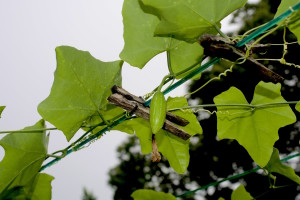
The green fruit is usually left untouched but wild denizens of the night like to eat ripe fruit left on the vine. Photo By Green Deane
Fruit is red for a reason. I first spied the Ivy Gourd when its candy-red fruit caught my eye as I drove over a railroad crossing. It was growing on a chain link fence by the tracks. That fall I dug up the root and the plant has been with me since. In fact I recently moved and like that cats, it went with me. Perhaps I should give it a name. Once in season it is fairly easy to spot because the cucumber-like fruit turns red as it ripens. You can eat it at any stage and it tastes like a slightly tart cucumber with a tougher skin. I don’t peel them, I just crunch away. Young leaves and growing tips are also edible.
The Ivy Gourd is not on this state’s invasive plant list but makes the cut in Hawaii where it escaped cultivation. The vine was introduced to that state as a backyard food crop and is sometimes called “Thai Spinach.” The two plants I have found over the course of several years are about a mile apart. Male and female plants are needed so there has to be guy somewhere around here. That it produces excellent fruit and is virtually maintenance and disease free does not exonerate it with some. I like that it’s a prolific producer of chunky cukes and takes total care of itself as “weeds” tend to do. It also likes to grow up rather than out thus saving space on my garden floor. This is definitely a permaculture species. To read more about the Ivy Gourd, also called Tindora, go here.
In case you missed receiving the newsletter last week that’s because there wasn’t one. EatTheWeeds.com is — for reasons unknown — under regular attacks by hackers, as if there is something secretive or seditious about edible wild plants. Last week’s disruption lasted for a little over week. It was an unintended vacation from the newsletter. Efforts are underway to reduce the frequency and scope of the hacks.
While teaching in West Palm Beach this past weekend a rather odd occurrence was observed: Honey Mushrooms in May, the thirty-first to be exact. “Honeys” are among Florida’s more easy to identify edible mushrooms (when well-cooked.) One usually spies them in the winter months starting around November and perhaps as late as February. This particular clump and several others were growing on a Banyan tree root. There are Honey mushrooms nearby on other Banyans in the winter but this is the first time seeing some this time of year. The report is not isolated. On two of my Facebook mushroom pages there have been a couple of other reports about seeing “Honey’s” out of season. To be accurate they are known to fruit anytime of year but it is rare to see them popping up outside of winter. On Facebook I moderate the Florida Mushrooms Identification Forum, Southeastern US Mushroom Identification, and Edible Mushrooms: Florida. To read more about Honey Mushrooms go here.
One can make a good argument that the two most difficult places to learn how to forage for wild food in the 50 united states are Florida and Hawaii. It’s all that tropical weather. However, it just got easier in the Aloha State with the publication of Wild Food Plants of Hawaii by my friend Sunny Savage. It’s 150 pages of personal experience and observation covering several dozen edible species. Many of them are familiar to all foragers as some weeds are truly global. Others are found where there’s really never a winter. Between the festive covers you will find photographs, recipes and wisdom. Wild Food Plants of Hawaii is the first book about wild edibles in that state for nearly 50 years, the last being Euell Gibbon’s Beachcomer’s Handbook published in 1967.
Sunny and her husband Ryan spent much time with my friend Kelly Fagan and I when they were preparing for their Caribbean sail-about (which was really a three-year honeymoon.) I even got to climb aboard the sailboat she, Ryan and son Saelyn called home for some 6,000 miles. And when they finally came ashore the land sickness Sunny felt was actually morning and a second son, Zeb, came along like a sprout in the spring. For a young mother Sunny has packed in a lot of living from a year in a research station in Antarctica to picking up a degree in Dietetics to speaking on a recent T.E.D. talk.
Sunny and I share several foraging themes. On page one she challenges us with her Wild Food Manifesto which is to eat one wild food a day. When I am asked how much wild food I eat I say I try to eat something wild every day. There are many reasons why one would want to ranging from the practical to the profound. The problem with modern food is that most of it is not real food. It’s manufactured food stuff with a list of contents one can’t pronounce. We are what our ancestors ate and modern food is not in synch with that. We have a genetic imperative that demands we eat a particular way for the best of health. The nutritional industrial complex has ignore that and the result is we are among the sickest populations on earth. Returning to wild food, even just a little, is reclaiming our heritage. Besides appealing to our genes and the significant influences of epigenetics wild foods also have textures, flavors, and better nutrition than their cultivated relatives. They are also only genetically modified by Mother Nature rather than the chemist in the kitchen.
Sunny’s book is warm, personal much like her (you’d never guess she’s shy and quiet.) You can get your own copy here.
Upcoming foraging classes:
Sunday, June 7th, Bayshore Live Oak Park, 23000 Bayshore Rd., Port Charlotte, FL 33980. 9 a.m.
Saturday, June 13th, Mead Garden: 1500 S. Denning Dr., Winter Park, FL 32789, 9. a.m.
Sunday, June 14th, Red Bug Slough Preserve, 5200 Beneva Road, Sarasota, FL, 34233, 9 a.m.
Sunday, June 21st, John Chestnut County Park: 2200 East Lake Road, Palm Harbor, FL 34685 9 a.m.
Saturday, June 27th, Boulware Springs Park, 3420 SE 15th St., Gainesville, FL 32641 9 a.m.
Sunday, June 28th, Jervey Gantt Recreation Complex, 2390 SE 36th Ave., Ocala, FL, 34471, 9 a.m.
For more information or to sign up for a class go here.
Need to identify a plant? Looking for a foraging reference? Maybe you have a UFO, an Unidentified Flowering Object, you want identified. On the Green Deane Forum we — including Green Deane — chat about foraging all year. And it’s not just about warm-weather plants or just North American flora. Many nations share common weeds so there’s a lot to talk about. There’s also more than weeds. The reference section has information for foraging around the world. There are articles on food preservation, and forgotten skills from making bows to fermenting food. Recent topics include: I Believe This Is a Tulip Tree, Virginia Creeper Again. Edible but too small, Here’s One I saw near the office, Transplanted Tree Root Structure, cultivated Apios Americana: Groundnut, My First Pokeweed, Yaupon Holly? Plantain? Sand Toads? Will My Tomatoes Make Me Pregnant? White BUgs on Smilax Tips, Poison Hemlock and Eating Birds, Study and Respect Plants, Firebow Elderberry, Not Yellow Pimpernel, Small Purple Flowers, Firebow Baccharis, Milkweed? Elderflower Fritters, and Fuzzy Tree. You can join the forum by clicking on the button on the upper right hand side of this page.
Subscribe to Green Deane’s weekly EatTheWeeds newsletter, upper right side of this page.

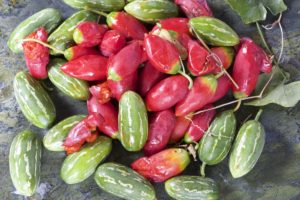
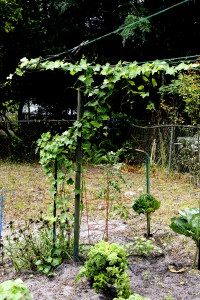
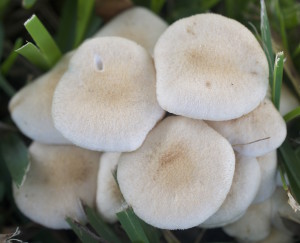


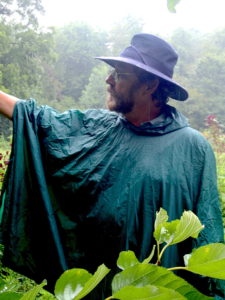
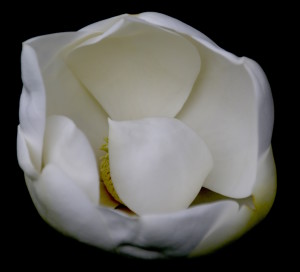

I just Love this newsletter!!! Green Deane, you are the Best!
Thank you for sharing your immense plant wisdom and good sense with all of us. Shame on those nasty hackers. boo.
I vote for “Gourdon”, of course. Obvious but apt, don’t you think? 😉 I enjoy your newsletter, and I hope to see more edibles I can recognize in our own known places! (S.C. Pee Dee region). Your enthusiasm and willingness to share all of this tasty subversiveness makes me richer…hmmm…maybe THAT has something to do with the hackers? (herbicides make me crazy. A weed is only something growing where you don’t want it to…I say eat it or move it if you have to.)
G. Deane: How fortunate for me that you chose the Ivy Gourd to top the newsletter as I was just introduced to a vine of that exact cucumber-type fruit by a neighbor down the road. I knew they looked familiar and the neighbor said that they were edible. I think they are on the DVDs, I’ll check. I thought it might be the Creeping Cucumber, but it was not. I was hoping to make the next Palm Harbor class, but my Sundays are booked solid to sell newspapers, I can’t afford to miss one. As soon as you have a class on a Saturday in my area, I’m there, magnifying-glass, notebook, tablet, and a couple of old books to give you. thanks, Doug
Sir, I’d rather delay my comment on those hackers; in the mean time, suffice here to remember a local saying: “Dogs howl and Camels are still on their way.”
While India and South East Asia are main exporters, Middle East and Arab Gulf countries are big consumers of Ivy gourd. For example, one can serve a special recipe “Ivy gourd in coconut sauce” called Tendli Buthi or the pickled ivy gourd in famous restraunts in Jeddah (Saudi Arabia). The pickled Ivy gourd characterized with a softer skin is sometimes given the same name “Gherkin” as the pickled cucumber.
It is interesting to note that some herb companies sell Ivy gourd extract e.g. 250 mg tablets as part of a healthy diet claiming to maintain normal blood glucose levels. It is also interesting to come across reports on recent research – year 2012 – that Ivy gourd mucilage can be used to reduce industrial wastewater turbidity. In this respect it has exceeded other plant polymers namely of: M. concensensi, T. natans, and A. esculentus.
I am in coastal Mississippi and grow a garden year round of domesticated vegetables as well as many wild esibles. I also forage, hunt and fish. With all the wonderful, and timely, rain this year my garden is probably the best and most beautiful I have grown in a long time, including the purslaine growing between the rows. I took a trip up to the middle of the state to Jackson this week and my traveling companion and I commented to each other how plush and green everything is this year from woodlands to wetlands to farmlands. We usually start to get infestations of chomping insects and worms by this time, but as yet, even though we are now into June, I am totally bug free. This may be because we had cooler weather later and cool nights later than usual so we will see what the warmewr weather of summer brings. On the causeway between Gautier and Pascagoula, MS I have discovered the largest patch of marshmallows I have ever found anywhere and they are in bloom with their hibiscus-like blossoms. My grandma made traditional marshmallows and candy out of the roots when we were growing up and I would like to do this but do not know how. Any ideas where I could get recipies or instructions?
We’ve been bone dry here… my grandmother loved marshmallows but I don’t have any of her recipes.
Mr. Deane,
My wife and I thoroughly enjoyed a recent walk in the park with you in Ocala. My wife and I are new to this foraging and it seems that just about everything you showed us was either edible or usable for medicinal purposes.
We are traveling to the Knightsville Dam Area in Russel Ma on Oct. 3rd.
What kind of plants should we be looking for to munch on ????? I’d like to study up on them before we go.
Thanks again,
Jeff & Colleen
The majority of the species will be the same. You can visits the sites of Blanche Derby and or Arthur Haines to get some local insight to plants in New England.
The good image of the vine made me reserve my NEW clothes line though for another species – Morning glory. I’ve ennjoyed Sunny Savage T.E.D. “Dietetics” . Indeed “Wild food of the people is for the people”. Tbanks for her, her advice to add one wild food a day to our food and many thanks for informing on more learning. Again,thank you for the clarification and your effort in reducing the frequency and scope of the hacks – all much appreciated. We’d like to tell those hackers that Truth seekers i.e. the deciples of mother nature are forever superior and worth to to follow which is more better to follow rong doers who are always behind. “And say, ‘The truth has come and falsehood has vanished'” May God forgive the hacker.
Hackers? Must be Monsanto. They want you to *kill*, not eat the weeds. 🙂